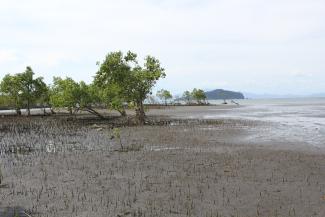Climate change
Ready to face the worst

Climate change is a dire consequence of human impact on nature, resulting in a variety of negative effects, like massive erosion or changing monsoon patterns. Poor people and the poorest countries have the least possibility to cushion blows when they hit. They need to prepare for floods that drown crops, storms that destroy shelters and droughts that turn arable fields into dusty deserts.
In the early days of global climate negotiations, the international community pledged to stop global warming. However, the efforts to mitigate the phenomenon were never enough to achieve that goal. Therefore it has become necessary to adapt to the impacts of climate change. To plan adequate infrastructure, one must use scientific climate models and assess risks and vulnerabilities diligently.
One of the consequences of global warming is the increasing frequency and force of tropical cyclones. Fishermen along the Philippine coastline, for instance, are among the communities that have to bear the brunt. The standard technocratic response would be to upgrade seawalls, but seawalls are too expensive for rural communities in the Philippines.
However, there is also the possibility to plant mangroves which dissipate wave energy. Nalini Rao of the US-based non-governmental organisation (NGO) Conservation International speaks of “ecosystem-based adaptation” (EbA), when solutions rely on what the natural habitat offers. “In order to assist the coastal communities along the Verde Island Passage in the Philippines,” Rao says, “Conservation International helps restoring the degraded habitats by planting mangroves.”
There are some problems with ecosystem-based adaptation (EbA) however, as Nalini Rao admitted during a seminar hosted by GIZ in Vilm in Germany in August. For instance, they may take time to take root. “A sea wall exists from day one, whereas mangrove trees take years to grow before they are effective against storms and floods,” was Rao’s assessment. On the other hand, the ecosystem approach has many advantages. For instance, solutions often do not require much spending on maintenance. In the Philippines, moreover, coastal communities collect crabs in mangrove forests to improve their livelihoods. Restoring the mangroves therefore has economic benefits beyond breaking the waves.
Internationally, there are efforts to funnel funds into adaptation. The Adaptation Fund (AF), which was established in the context of the UNFCCC (United Nations Framework Convention on Climate Change) in the past decade, dedicated more than $ 180 million to increasing climate resilience in 28 countries around the world in the past two years. Germany too has pledged money for supporting adaptation in developing countries.
It is not easy to channel the funding to where it is most effective however. Raju Pandit Chhetri from Clean Energy Nepal, an NGO, says there is a need for monitoring mechanisms to ensure accountability when international agencies fund national ministries in various countries. He criticises that technical assistance from donors only lasts for the time allotted to a specific project. In his view, more capacity building is necessary, for countries will otherwise remain dependent on outside help.
According to Alexander Froede of the GIZ, the institutions which work on adaptation to climate change are usually quite new. Involving NGOs is not easy in this context, because there are no long track records of meaningful engagement, he told a conference held by the AF and an NGO network in Bonn in July. There is already a lot of expertise however, he added. GIZ considers ecosystem-based adaptation most promising in the long run, so it funds projects that take this approach internationally.
Sheila Mysorekar








